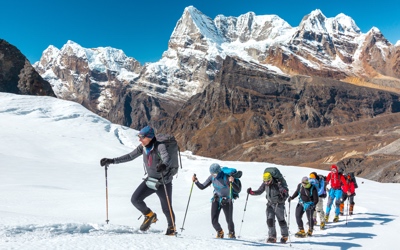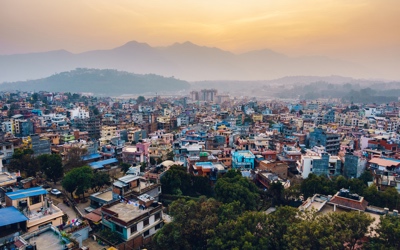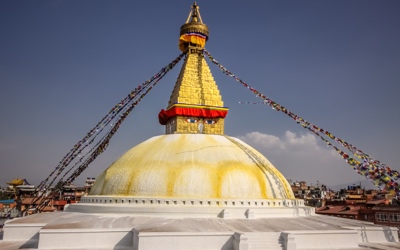
Half-Day Tour to Swoyambhunath Stupa
5 h
Half Day
Instant confirmation
About this activity
You can start this guided trip either in the morning or in the afternoon driving 3 KM to the Swayambhunath Stupa from the Kathmandu City. It is commonly known as the Monkey Temple as there are holy monkeys living around the temple territories.
Although the site is considered Buddhist, the place is revered by both Buddhists and Hindus. Numerous Hindu monarch followers are known to have paid their homage to the temple, including Pratap Malla, the powerful king of Kathmandu, who is responsible for the construction of the eastern stairway in the 17th century.
There is a large pair of eyes on each of the four sides of the main stupa which represent Wisdom and Compassion. Above each pair of eyes is another eye, the third eye. It is said that when Buddha preaches, cosmic rays emanate from the third eye which acts as messages to heavenly beings so that those interested can come down to earth to listen to the Buddha. The hellish beings and beings below the human realm cannot come to earth to listen to the Buddha's teaching; however, the cosmic rays relieve their suffering when Buddha preaches. Between the two eyes (also called Wisdom Eyes), a curly symbol, symbolizing the nose, is depicted which looks like a question mark, which is a Nepali sign of number figure one. This sign represents the unity of all things existing in the world as well as the only path to enlightenment through the teachings of Buddha.[9]
There are carvings of the Panch Buddhas (five Buddhas) on each of the four sides of the stupa. There are also statues of the Buddhas at the base of the stupas. Panch Buddhas are Buddha in a metaphorical sense in Tantrayana. They are Vairochana (occupies the centre and is the master of the temple), Akshobhya (faces the east and represents the cosmic element of consciousness), Ratna Sambhava (faces the south and represents the cosmic element of sensation), Amitabha (He represents cosmic element of Sanjna and always faces the west) and Amoghsiddhi (He represents the cosmic element of confirmation and faces the north).
Read more
Show less
Although the site is considered Buddhist, the place is revered by both Buddhists and Hindus. Numerous Hindu monarch followers are known to have paid their homage to the temple, including Pratap Malla, the powerful king of Kathmandu, who is responsible for the construction of the eastern stairway in the 17th century.
There is a large pair of eyes on each of the four sides of the main stupa which represent Wisdom and Compassion. Above each pair of eyes is another eye, the third eye. It is said that when Buddha preaches, cosmic rays emanate from the third eye which acts as messages to heavenly beings so that those interested can come down to earth to listen to the Buddha. The hellish beings and beings below the human realm cannot come to earth to listen to the Buddha's teaching; however, the cosmic rays relieve their suffering when Buddha preaches. Between the two eyes (also called Wisdom Eyes), a curly symbol, symbolizing the nose, is depicted which looks like a question mark, which is a Nepali sign of number figure one. This sign represents the unity of all things existing in the world as well as the only path to enlightenment through the teachings of Buddha.[9]
There are carvings of the Panch Buddhas (five Buddhas) on each of the four sides of the stupa. There are also statues of the Buddhas at the base of the stupas. Panch Buddhas are Buddha in a metaphorical sense in Tantrayana. They are Vairochana (occupies the centre and is the master of the temple), Akshobhya (faces the east and represents the cosmic element of consciousness), Ratna Sambhava (faces the south and represents the cosmic element of sensation), Amitabha (He represents cosmic element of Sanjna and always faces the west) and Amoghsiddhi (He represents the cosmic element of confirmation and faces the north).
Included
- Bottled water
- Professional art historian guide
- Hotel pickup and drop-off
- Transport by private vehicle with driver
Not included
- Lunch
- Gratuities
Additional
- Confirmation will be received at time of booking
- Most travelers can participate
- No heart problems or other serious medical conditions
- Not wheelchair accessible
- This is a private tour/activity. Only your group will participate
Features
Tourism
90%
Cultural
75%
You may also like









 See all 37 Collections
See all 37 Collections
Click to discover other experiences
See all

Collections
Hiking
82 Activities

Collections
Nagarkot Trek
73 Activities

Collections
Food & Cooking
16 Activities

Collections
Kathmandu Valley
65 Activities

Collections
Sightseeing
58 Activities

Collections
Temples Tour
22 Activities

Collections
Everest Base Camp Trek
151 Activities

Collections
Bhaktapur
39 Activities

Collections
Other trips
96 Activities

Collections
Patan Durbar
25 Activities


